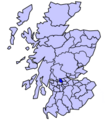Strathkelvin facts for kids
| Strathkelvin | |
| Scot1975Strathkelvin.png | |
| Geography | |
| HQ | Kirkintilloch |
| History | |
| Created | 16 May 1975 |
| Abolished | 31 March 1996 |
| Succeeded by | East Dunbartonshire North Lanarkshire |
Quick facts for kids Politics |
|
|---|---|
| Governance | Strathkelvin District Council |
Strathkelvin is a name that refers to the valley (or strath) of the River Kelvin in west central Scotland. This area is located north-east of Glasgow.
Between 1975 and 1996, Strathkelvin was also the name of a local government area. It was one of 19 districts within the larger Strathclyde region in Scotland.
Contents
What was Strathkelvin?
Strathkelvin was a local government district. This means it was an area with its own council. This council was in charge of local services. These services included things like housing, parks, and waste collection.
When was Strathkelvin created?
The Strathkelvin district was created in 1975. This happened because of a new law called the Local Government (Scotland) Act 1973. This law changed how local areas were managed across Scotland.
Before 1975, Scotland had different types of local areas. The new law created a two-level system. There were larger regions and smaller districts within them. Strathkelvin became one of the districts in the Strathclyde region.
What areas did Strathkelvin cover?
The new Strathkelvin district brought together parts of several older areas. These older areas were from three historic counties:
For example, it included the towns of Kirkintilloch and Bishopbriggs. It also covered surrounding rural areas.
How did Strathkelvin get its name?
When the new districts were first planned, Strathkelvin was going to be called "Bishopbriggs and Kirkintilloch". However, the local council members elected in 1974 wanted a different name.
They asked for the name to be changed to "Strathkelvin". This name refers to the River Kelvin valley, which runs through the area. The government agreed to this change before the new district officially started.
When did Strathkelvin stop existing?
The Strathkelvin district was abolished in 1996. Another new law, the Local Government etc. (Scotland) Act 1994, changed things again. This law replaced the regions and districts with new, single-level council areas.
Most of the Strathkelvin area became part of the new East Dunbartonshire council area. However, some parts, like the Chryston and Auchinloch areas, joined North Lanarkshire.
The name Strathkelvin is still used today. For example, it's part of the name for a local court area called "Glasgow and Strathkelvin".
Who was in charge of Strathkelvin?
The Strathkelvin District Council was in charge of the area. The first election for this council was in 1974. The council officially started its work on 16 May 1975.
Which political parties were in control?
The council's political control changed over time:
| Party in control | Years | |
|---|---|---|
| No overall control | 1975–1980 | |
| Labour | 1980–1996 | |
- From 1975 to 1980, no single party had full control. This is called "no overall control".
- From 1980 until it was abolished in 1996, the Scottish Labour party was in control.
Who were the leaders?
The council meetings were led by a person called the provost. For the first two years, the provost also led the council's main policy committee. After 1977, the council chose a separate leader of the council. This leader was in charge of the political direction. The provost's role became more ceremonial.
The last leader of the Strathkelvin Council was Charles Kennedy. He later became the first leader of the new East Dunbartonshire Council.
Where was the council based?
When it first started, the council worked from several different offices. In 1985, a new main building was built in Kirkintilloch. This building was called Tom Johnston House.
Tom Johnston House was named after Tom Johnston. He was born in Kirkintilloch and was an important politician. He served as the Secretary of State for Scotland during the Second World War.
After the council was abolished in 1996, Tom Johnston House became the headquarters for the new East Dunbartonshire Council until 2012. The building has since been taken down.
Images for kids


